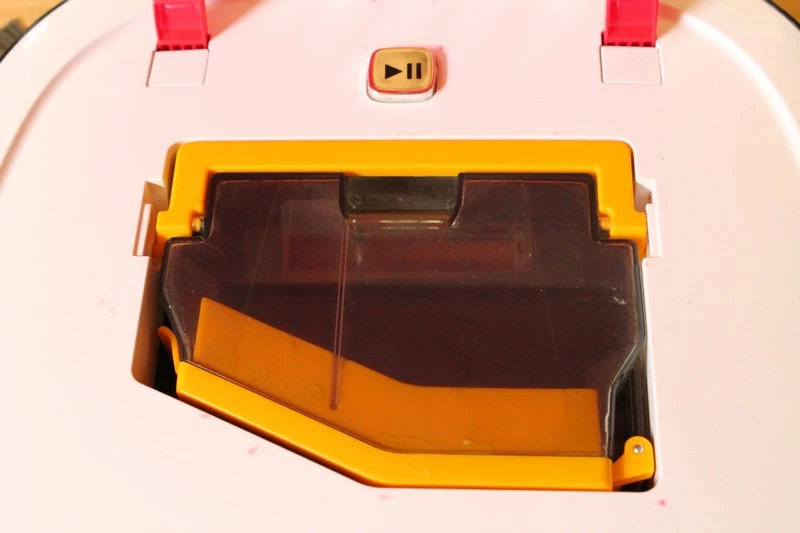The robotic vacuum cleaner continues to be a category of product that is really cool at a conceptual level, but still fails make the traditional manual vacuum – or even the centuries-old technology in your household broom – fully obsolete. Unfortunately, even robotic vacuums like the Ecovacs Robotics Deebot D35 are no exception.
Gizmag has spent the past few weeks testing out the D35 Bare-Floor Vacuuming Robot, and while it's drastically less expensive than best-of-class autonomous vacuums like the Roomba and cleans fairly well, it has a hard time truly working independently.
Let's start with one of the key selling points of the D35, its cost-reducing lack of a central agitator brush that most vacuums use to "sweep" the floor and loosen all kinds of detritus to make it easier to suck up. Because this particular Deebot is meant exclusively for bare floors, including surfaces like hardwood, laminates, tiles, brick, cement or vinyl flooring, there's less need to use a brush to dig particles out of the fibers of rugs or carpeting.
This direct suction approach does result in no tangled strands of junk around the main brush, and easier maintenance.
In general, the D35 picks up a variety of materials pretty well, from dirt and pet hair to even small leaves and bits of paper and plastic. It also prides itself on sporting two forward rotating brushes to sweep more debris into the path of its suction – the Roomba has only one brush. It's quite easy and intuitive to operate with just one real button to speak of, and emptying and cleaning its canister and filter are also straightforward.
Like most other robotic vacuums, its low profile allows it to clean under most furniture easily without having to move any heavy tables or sofas. Armed with infrared sensors, the D35 consistently avoids driving over ledges or steps and also uses "soft-touch object detection" to keep from crashing into things. These systems don't work perfectly, as we'll explain more in a moment, but function almost well enough to trust the robot not to damage itself or anything in the house as it scoots around. Almost.

This brings us to the D35's shortcomings, which in a nutshell, come down to the fact that it cannot be trusted to do its job consistently without human supervision. This became abundantly clear within just a few minutes of letting it loose on a combination of hardwood and brick floors.
It got stuck on the slightly raised threshold between rooms, and then on a power cord along the edge of a wall, then a throw rug, then a floor mat, then the threshold again, and again, and again.
Another day it found itself stuck in a corner of a room, its random movement algorithm unable to work its way out of the roughly square-foot patch of floor it dutifully cleaned for several minutes before being manually relocated ... to promptly get stuck on the threshold again.
We tried putting newspaper over the thresholds to help the D35, to no avail. We had success for a while by simple blocking the robot into one room at a time using yoga mats and pieces of lumber. With all obstacles cleared of its way that time, it had the dining room floors free of debris in a few passes within about 30 minutes ... until it pushed the threshold-blocking piece of lumber into a pet food bowl, overturning it all over the freshly-cleaned floor. Its path to the threshold suddenly clear, it then got stuck on it once again.
Even when working in an ideal, empty or completely obstacle-free space, the D35 may take its time to clear the space of junk, in part because the two rotating brushes have a tendency to send particles flying across the floor. To its credit, though, it does seem to eventually get it all, given enough passes without getting stuck.

The D35 is quiet for a vacuum, but a little loud for a robot that's supposed to be operating mainly at night. Also, its scheduling system is very basic and can be automated to run just once a day. Otherwise, you'll need to start it manually and it will then return to its charging base on its own once its battery is depleted after a few hours. Unless, of course, it's pushed its own charger accidentally into a corner where it can't access it, as happened once in our tests.
Securing the charger to a wall or floor could solve this problem, but this again gets at one of the main shortcomings, which is how much babysitting and accommodation the D35 needs.

Despite all those problems, we almost want to recommend this little robotic helper just because of how attractive and fascinating it is to watch. Something about its random movement algorithm is almost captivating, and at just US$160 it could be a good entry into the robotic floor maintenance world for someone with the barest of bare floors.
For most consumers though, you may want to consider something a little more advanced with a little bit more smarts at avoiding obstacles or additional measures like the "virtual walls" that can be set up to tell certain Roombas where not to go.
... or you could just stick to the old broom or manual vacuum for now.
Product page: Ecovacs Robotics















